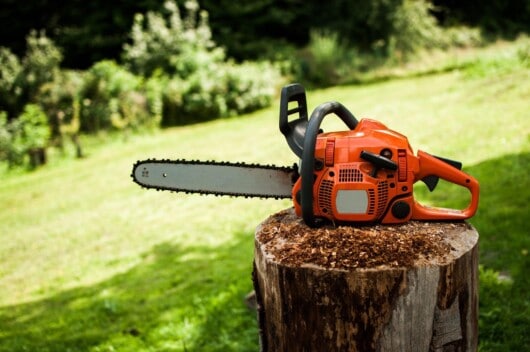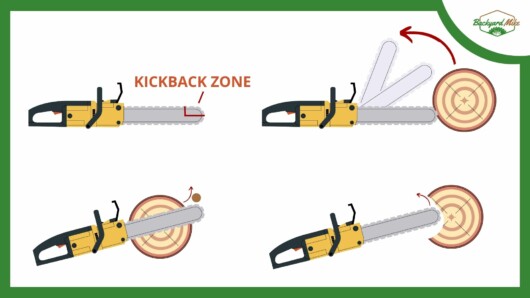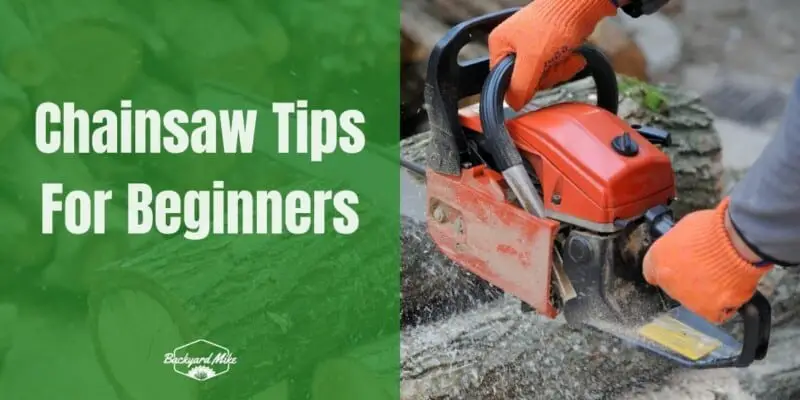Are you a beginner looking to work your way around a chainsaw for the first time? Don’t worry, even the most efficient chainsaw professional started out as a beginner. With time and the right knowledge, even you can become proficient at using a chainsaw.
There are certain chainsaw tips for beginners that every newbie needs to know about. Not only will these help you be more efficient with work, but they’ll also keep you safe.

Important chainsaw tips for beginners to keep in mind
Know the capabilities of your chainsaw
When tackling any wood-cutting task, it is essential to know the limits and capabilities of your chainsaw. If you’ve chosen a smaller model, it’ll be easier to handle the chainsaw, but it’ll limit the possible cutting size. You will need to choose a larger model having more power if you need to cut large trees.
Besides the size of your chainsaw model, another important point to consider is the length of the bar. Longer bars are commonly used for felling trees, while shorter bars will work for branches. Once you’ve established the capabilities of your chainsaw and the correct bar size, then comes the matter of safety.
Study the working environment
The nature of your working environment will affect the progress or issues with your chainsaw. Not having the right working conditions could stop you from using the chainsaw like you wanted to.
If you are cutting trees, ensure that there is nothing attached to the tree as it could come crashing down. You wouldn’t want objects falling from the trees when it is being cut.
Confirm that the surrounding is free from any substances that could affect your position or harm your body.
Also, make sure there isn’t any garbage or unnecessary objects lying around the area where you are going to work. Further, make sure that there are no loose branches above the working area that could potentially fall on you.
Wear the proper safety gear
Before you start your project, it’ll be important to wear the proper safety gear. Accidents can happen at any moment, and you’ll want to ensure that your body is protected against accidents. Prioritize your safety and keep the safety standards in mind before you carry out any tasks on a chainsaw.
The important protective gear that you should wear include –
- Ear protection
- Safety glasses
- Protective footwear
- Protective gloves
- Chainsaw chaps
- Assess your chainsaw
Don’t just bring out your chainsaw from the storage area and start cutting or pruning right away. Assess the condition of your chainsaw. Moreover, lubricate the necessary parts and make sure that the tension in the chainsaw chain is perfect. If it isn’t, you’ll be doing your chainsaw damage that could have been avoided.
Moreover, check the gauge settings and look at the necessary safety features to confirm that it’s in perfect shape. If you observe any issues with the chainsaw, something might have been out of place. Avoid using the chainsaw until it is fixed.
Starting the chainsaw
Starting the chainsaw will begin with placing the chainsaw on a flat surface near the working area. If you have a battery-powered chainsaw, ensure that the batteries are full. However, never overcharge the batteries as it could easily reduce the battery lifespan. If you’re using a gas-powered chainsaw, check the fuel level and try to use environmentally friendly fuels. If you’re working with a corded electric chainsaw, make sure that you don’t have anything laying or blocking the cord.
Once you’re ready to start the chainsaw, pull the choke out on gas-powered chainsaws, especially in cold weather. Battery-powered or electric chainsaws aren’t affected by cold temperatures.
Next up, ensure that the chain brake is engaged. Push the chain brake forward until you get the clicking sound. This stops the chain from spinning if there is a sudden kickback, while also keeping you safe when starting the chainsaw. The next step involves pumping the primer, which will purge the air from the gas line. Push it 4-5 times and force gas into the carburetor. Place your foot into the handle and firmly grip the handle with your left hand. Grab the starter role with your right hand and pull it out slowly until you start feeling resistance.
Once you start feeling the resistance, give the rope a firm pull. You may need to tug a few times. Between the pulls, let the rope slide back into place steadily. The rope snapping back into the chainsaw could easily damage the starter mechanism.
If after multiple pulls, you hear the engine rev but not start, you should push the choke back halfway. Your gas-powered chainsaw will likely start after a few pulls. Once it starts running, depress the throttle to keep the engine running. Some models might need to set the choke to idle. Read the user manual as you’ll find the specific starting instructions.
Here are a few important chainsaw safety tips to remember when starting the chainsaw.
- Never attempt a drop start. It is an advanced technique, and it’ll likely increase your risk of injury.
- Remember to hold the starter rope directly in your hand instead of wrapping it around your hand.
- Don’t try to start the chainsaw if the bar gets stuck in the wood. There is a risk of kickback involved.
- Remember to read the user manual if any specific issue comes up.
- Make the initial cuts
When you are ready to start cutting, begin by holding the chainsaw firmly with both hands. Keep the machine close to you. Plant your feet firmly on the floor while spreading the shoulder width to make sure you maintain proper balance. If you are cutting light material, be sure that you’re cautious of bits and pieces that could end up projecting. For larger pieces of wood, you should use extreme caution if you wish to re-enter the cut.
Use the chainsaw below the shoulder level
The chainsaw shouldn’t be used above the level of your shoulders. If you use it above your shoulders, you’re less likely to have a bird’s-eye view of the objects you’re cutting. This will increase the risk of a potential chainsaw kickback.
Avoid using the chainsaw on a ladder
Sometimes, you may have to cut branches that are beyond your reach. Using the chainsaw on a ladder might feel like the only possible option, but it isn’t. Instead, prefer using a pole saw.
Should the chainsaw face a kickback, you’ll likely fall, and the outcome might be grave. You should keep in mind how heavy the chainsaw is and how forceful the kickback will be.
Have the right stance and posture
When using a chainsaw, you’ll need to hold the chainsaw properly. A proper stance should be prioritized even if it isn’t the most comfortable option. Always support your chainsaw with both hands and keep it near you at all times.
A balanced stance is very important, especially when you consider the risks involved with using a chainsaw. When cutting branches or pruning bushes, focus on the task and don’t move your body around. This could easily result in a kickback while making you imbalanced.
When cutting trees
If you’re cutting trees, ensure that you’re adhering to the state laws while also keeping safety in mind. Avoid cutting trees in poor weather conditions like heavy wind, rain, or snow. Have a plan in your head for the way you’ll cut the trees and in which direction the wood will fall. Remember to take the wind into account when you are planning the area where the wood will fall.
Never attempt to cut the tree at a height above your shoulders. Do ample research on how to safely cut through large trees and ensure the safety protocols. Once you’re finished with the task, ensure that you maintain the chainsaw, as a well-maintained chainsaw will perform better. Moreover, it’ll also have a longer lifespan.
The risk of kickback
Chainsaw kickback is the most dangerous aspect of a chainsaw. It is a serious situation that can strike anyone, anytime.
A chainsaw kickback is when the saw’s guide bar rotates back towards your body at a fast speed. It’ll occur if the chainsaw’s tip nicks a hard object or if the chain gets pinched between the wood.

As a beginner, you need to take all the necessary precautions for preventing chainsaw kickback from striking. Here are a few important tips to remember if you want to avoid kickback.
- Hold the saw firmly with both of your hands.
- Never cut wood with the tip of the chainsaw blade.
- Remember to test the chain brake before you start cutting. It could be the difference between a minor injury and a life-threatening incident.
- Never cut through wood that has previously been used as building materials. It might contain nails or other hand objects hidden inside.
- When you are re-entering a cut, always proceed with extreme caution and go slowly.
- Chainsaw maintenance
Proper maintenance is key to having a long-lasting chainsaw in premium condition. After every use, make sure that you follow these maintenance steps –
- Ensure that the bolts and other parts are tight.
- Lubricate the chainsaw components so that they’re not dry.
- Empty the gas tank each time after use if you’re using a gas-powered chainsaw.
- Clean the chain and guide bar after use.
- Clean the air filter of any sawdust.
Conclusion
Thank you for reading. Hopefully, now you know the necessary chainsaw tips that will have you cutting wood like a pro. Keep all these tips in mind to get exceptional performance and a long lifespan from your chainsaw. Also, make sure that you keep the safety tips in mind because using a chainsaw is always risky business.


